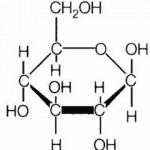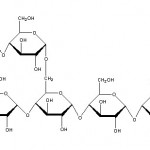Okay, so many of you are wondering how something that does not even taste sweet, like a piece of bread, can raise blood sugar more than something that tastes sweet, like a pear. And what the heck is blood sugar, anyway?
Here’s the deal: sugar is a kind-of generic term, and there are several types of “sugars” in the foods we eat and in our bodies. Glucose is the one our bodies use for energy, and it is what we measure to determine your blood sugar level. It looks like this:
Fructose is another sugar molecule, found most often in fruits. Lactose is a sugar molecule found in dairy products. They are all similar, but a little bit different in where the atoms attach to each other. Most of our cells have GLUTs in their membranes – glucose transporters – that allow glucose to enter the cell and then be burned for energy. These transports are very specific to glucose, they don’t just let in any sugar. We’ll talk more about how these work in a minute.
Sucrose, or table sugar, is one molecule of glucose attached to one molecule of fructose. Fructose does not hang around in our bloodstream, waiting to be picked up by cells and used for energy. Fructose goes to the liver, and then is made into any number of things. Lactose is a glucose molecule attached to a galactose molecule. Galactose is another sugar that tends to be absorbed by the liver and turned into other things as well. Confused yet?
Since our cells use glucose for fuel, that is the sugar that goes through our bloodstream to feed them. While the other sugars taste sweet too, they do not have any direct affect on our blood glucose level.
Starches found in breads, cereals, grains, beans, etc. are basically long chains of glucose molecules. The whole shebang goes to the bloodstream, not just half. They look like this in scientist shorthand:
So even though they may not taste as sweet, they have a bigger impact on our blood sugar. Starting to see how this works? Good.
These sugar and starch molecules all get broken apart by enzymes in our digestive system. Enzymes are basically matchmakers that attract molecules and place them in the exact configuration necessary to create a biological reaction. In this case, breaking starch molecules apart so they can be absorbed. There are many types of enzymes to help us with digestion – in fact every reaction in the body is sped-up by our enzymes – but for today we will focus on the ones that help us digest sugars.
The speed at which these enzymes break up the sugars and starches determines how quickly they are available for absorption. And it is the quick rise in blood sugar that can cause problems. Enzymes can only work on the surface area of the food being digested, so the more surface area that is available to them, the quicker they get the job done. Food that takes longer to break down in the digestive system provides a slower release of sugar. That is why the flour particles in bread, which are so small they provide lots of surface area, raise our blood sugar faster than a wheat berry, which has a relatively small amount of surface area.
Other molecules, like proteins, fats and fibers getting in the way also slow the process down.
Why is slower better? Good question. Insulin works by activating the GLUTs in muscle and fat cells, enabling them to take up and store large amounts of glucose and get it out of the blood before it does damage anywhere. It takes some time for the digestive system to signal for the release of insulin, and then for it to work throughout the body. So our blood glucose level gets really high before insulin brings it back to normal. In the meantime, extra glucose molecules are attaching themselves to other cells and hindering their functioning, sometimes causing real damage. If glucose is absorbed slowly into the blood, insulin has time to work and keep everything in balance.
Why do we need blood sugar at all? Glucose is the only fuel for nerves, the brain, and red blood cells, so we need a steady supply of it for those tissues. Organs also use mostly glucose for fuel. That is why their GLUTs are not dependent on insulin to be “turned on.” But I digress.
So, how do we slow down the absorption of glucose into our blood so we have just enough? Those “other” molecules help a lot. Fiber is basically starch that doesn’t fit into our enzymes and therefore can’t be digested. It forms gels and nets that trap sugar molecules inside; only as they move around sugars kind of escape and become available to enzymes. Proteins and fats just get in the way – remember all of these guys are mixed up together in the stomach, no matter how separate they may be on your plate.
By eating sugars and starches that come with fiber – like vegetables, fruits, beans and whole grains – and adding foods with some protein and healthy fats, we keep our blood sugar steady. And all of our organs happy.


Leave a Reply